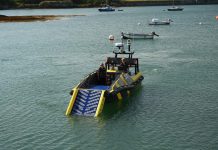Rapid expansion of offshore wind development worldwide is posing operation and maintenance challenges as turbines are installed in increasingly remote locations, harsh environments, and deeper waters. This demands Service Operation Vessels (SOVs) are equipped with flexible solutions for secure transfer of maintenance crews in difficult operating conditions, according to Vestdavit.
This requirement has resulted in an increasing level of orders for the Norwegian supplier of boat-handling systems on the strength of its capability to develop versatile davits for heavy-duty workboats able to safely transport personnel and equipment in variable sea states, with deliveries to the likes of Norwind Offshore, Esvagt, and Rem Offshore.

According to research firm Rystad Energy, investments in global offshore wind are set to more than double over this decade from $46 billion in 2021 to $102 billion by 2030.
Europe is leading the way as the largest offshore wind region with 8,500 turbines expected to be operational by 2030, based on projected investments of $53 billion by countries including the U.K., Spain, Norway, Denmark, and Poland. As well as an increase in project volume, offshore wind farms are expanding both in scale and the size of turbines (15-22 MW).
This, combined with potential turbine reliability issues due to rapid technological evolution of new models every few years, raises the requirement for regular maintenance of multiple turbines across an extensive wind farm to ensure continued uptime.
At the same time, wind-farm owners need to minimize operation and maintenance costs and maximize turbine reliability and project revenue over a typical project lifetime of 20-25 years.
“Consequently, there is a requirement for SOV operators to be able to provide safe and efficient deployment of work crews and equipment to perform effective maintenance on several turbines simultaneously across a wide sea area within a tight operational window,” said Vestdavit Managing Director Rolf Andreas Wigand.
An SOV can serve as a self-supporting mother vessel for many service engineers while being stationed over an extended period a long distance from shore, with some wind farms over 100 kilometers offshore.
This results in savings in cost and energy used for maintenance, a need for fewer SOVs, reduction of non-operational downtime, and increased turbine availability.
Vestdavit has bolstered its market position in offshore wind after both gaining new customers and winning repeat orders with existing customers, and its systems are now being used by about 80 percent of all offshore wind vessel operators.
More info www.vestdavit.com


























